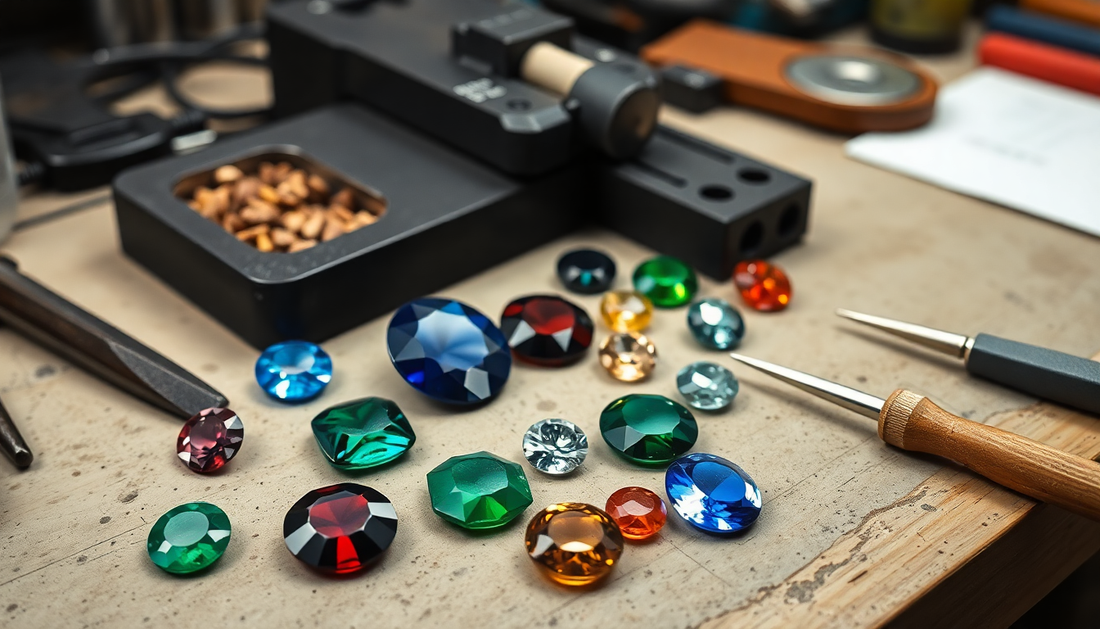
A Beginner's Guide to Faceting Gemstones: Techniques, Tips, and Tools for Success
Share
Introduction
Faceting gemstones is an intricate art that transforms rough stones into dazzling jewels. This guide is designed for beginners, providing essential techniques, tips, and tools to help you succeed in your faceting journey. Whether you're looking to create stunning pieces for personal use, gifts, or even to sell, understanding the fundamentals of faceting will set you on the right path.
Understanding the Basics of Gemstone Faceting
Before diving into the techniques, it's crucial to understand what gemstone faceting entails. Faceting is the process of cutting flat surfaces (facets) on a gemstone to enhance its brilliance and overall appearance. Here are some key aspects to consider:
- Rough Gemstone: The uncut stone from which you will create your masterpiece. Choosing the right rough is essential for achieving the desired final look.
- Facets: The flat surfaces that reflect light and create sparkle. The arrangement and number of facets can greatly influence the gemstone's brilliance.
- Polishing: The final step that gives the gemstone its shine. Proper polishing can enhance the light reflection and color saturation.
- Indexing: A method used to measure and mark the angles and positions of the facets to ensure precision in cutting.
Essential Tools for Faceting Gemstones
To get started with faceting, you'll need the right tools. Here’s a list of essential equipment that every beginner should have:
- Faceting Machine: A specialized machine that holds the gemstone and allows precise cutting. Look for a model that offers ease of use and versatility.
- Lapidary Saw: For cutting rough stones into manageable pieces. A good quality saw will save you time and effort.
- Diamond Wheels: Used for grinding and shaping the facets. Different grits are available for various stages of faceting.
- Polishing Pads: For achieving a high-gloss finish. Make sure to have a range of polishing pads for different materials.
- Safety Gear: Include goggles and a dust mask to protect yourself while working. Safety should always come first.
- Calipers and Ruler: For measuring dimensions accurately, ensuring your facets are symmetrical and proportionate.
- Gemstone Dop Sticks: These are essential for holding the gemstone securely during the cutting process.
Techniques for Successful Faceting
Now let's explore some techniques that will aid you in achieving professional results:
- Choosing the Right Gemstone: Start with softer stones like quartz or garnet before progressing to more challenging materials like sapphires or diamonds. This will help you build your skills gradually.
- Planning Your Design: Sketch the desired shape and layout of the facets before you start cutting. Consider the stone's natural features and how they can enhance your design.
- Understanding Angles: Each facet should be cut to a specific angle to maximize light reflection. Familiarize yourself with the concept of critical angles and how they apply to different gemstones.
- Precision Cutting: Take your time and make small adjustments to ensure accuracy. Rushing can lead to mistakes that can be costly and time-consuming to fix.
- Consistent Polishing: Use the appropriate grits and techniques to achieve a uniform shine. Make sure to clean the gemstone between different grits to avoid contamination.
- Inspecting Your Work: Regularly check your facets with a jeweler's loupe or microscope. This will help you spot any imperfections early in the process.
Tips for Beginners
Here are some helpful tips to enhance your faceting skills:
- Practice Patience: Faceting requires time and attention to detail; don’t rush the process. Remember that mastery takes time and practice.
- Join a Community: Engage with local gem clubs or online forums to share experiences and learn from others. Networking can provide invaluable insights and support.
- Study Gemstone Properties: Understanding hardness, clarity, and color will help you make informed choices. Familiarize yourself with the Mohs scale of hardness.
- Keep a Faceting Journal: Document your projects, techniques, and lessons learned. This will help you track your progress and refine your skills.
- Experiment with Different Styles: Don't be afraid to try various cutting styles, such as brilliant cut, step cut, or mixed cuts. Each style will teach you something new.
- Invest in Quality Materials: High-quality rough stones and tools will yield better results and enhance your overall experience.
Common Mistakes to Avoid
As a beginner, it’s easy to make mistakes. Here are some common pitfalls to watch out for:
- Skipping Safety Gear: Always wear safety goggles and a mask to protect against dust and debris.
- Neglecting Measurements: Failing to measure angles and dimensions can result in uneven facets.
- Ignoring Light Reflection: Not considering how light interacts with your cuts can lead to dull-looking stones.
- Over-polishing: While polishing is essential, overdoing it can wear down facets and affect the stone’s integrity.
Resources for Further Learning
If you're eager to learn more about faceting gemstones, consider these resources:
- Books: Look for titles like "Gem Cutting: A Lapidary's Manual" by John Sinkankas or "Faceting for Beginners" by John P. Dyer.
- Online Courses: Platforms like Udemy and Coursera offer courses on gemology and faceting.
- YouTube Tutorials: There are numerous channels dedicated to lapidary arts that provide visual guides and tips.
- Workshops: Participate in local workshops or classes to gain hands-on experience and learn from experts.
Conclusion
Faceting gemstones is a rewarding craft that combines artistry and skill. With the right tools, techniques, and a little practice, you can create stunning gems that showcase your unique style. Embrace the journey, and let your creativity shine! Remember, every expert was once a beginner, so take your time and enjoy the process of learning and creation.